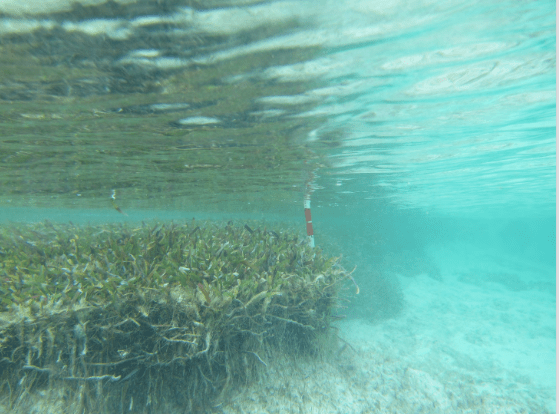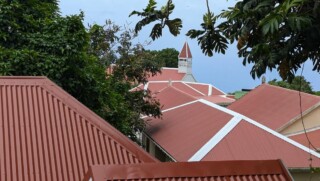Importance of Seagrass in protecting Caribbean Coastlines

Kralendijk -Researchers from the Netherlands and Mexico studied three bays on Saint Martin to illustrate the ability of seagrass and algae fields to with-stand hurricane level storms while continuing to dissipate energy and anchor sediments. Through field surveys, biomechanical measurements and computer simulations this project demonstrated the importance of coastal ecosystems in the protection of coastlines.
Coastlines around the world are experiencing a wide range of issues, as the effects of global warming are leading to an increase in coastal erosion and intensifying of storms. Fortunately, nature has provided a line of protection which is likely the most sustainable and effective solution. The Caribbean coastal ecosystem often includes fringing coral reefs, which act as a surf break to shelter the sandy lagoons and bays behind them. These protected areas provide the perfect environment for seagrass and macroalgae meadows, linking these two distinct environments together. Seagrass and calcifying algae work to stabilize sediment with their roots and lessen wave energy through their leaves and the complex bottom topography they create.
Hurricane Protection
Native seagrass, Thalassia testudinum, has been seen to be very resilient in the face of storms. The long, flexible leaves of seagrass work to capture and stabilize sediment, which overtime creates a complex bottom bathymetry. This in turn leads to waves been refracted within the shallow waters, causing a lessening of wave energy as they propagate into shallower areas. It is in this way that these seagrass and algae meadows work to fortify the sandy bottoms and minimize wave energy reaching the beach face, allowing these areas to withstand the brutal forces of hurricanes.2017 marked the most active and destructive storm season for the Caribbean since 1970. Saint Martin was hit by 3 hurricanes, two of which were category 5; Hurricane Irma, Jose and Maria. Researchers worked to compare the seagrass beds before and after this hurricane season to understand the influences of these areas on protecting coastline during hurricanes. This study used a combination of field surveys, biomechanical measurements and wave modeling simulations to understand how Caribbean seagrass meadows respond to storm events.
The Study
Between October 2015 and March 2016, researchers conducted monitoring along three sites along the east coast of Saint Martin. These areas were selected because of the different types of hydro-dynamic characteristics they represented, wave-sheltered (Baie de L’Embouchure), wave-exposed (Orient Bay) and unidirectional flow (Islets de L’Embouchure). All three sites have large seagrass and calcifying macroalgae meadows and are next to a coral reef, which protects them from the largest waves. Six months after the destructive hurricane season of 2017, researchers returned to these three sites to reexamine these meadows to determine the long-term effects of the storms. In addition, researchers were able to use computer modelling simulation to run a variety of scenarios to see how the different bottom topography of the Baie de L’Embouchure altered the level of coastal protection. Researchers focused on three main scenarios: (1) waves entering the bay with flat, smooth bottom and no vegetation, (2) waves entering with a biogeomorphic bottom (uneven sand) but no vegetation and (3) a healthy seagrass meadow with biogeomorphic bottom and lush seagrass.
The Results
Researchers found that even after the extreme conditions of the 2017 hurricane season, there was very little change in the bathymetry and make up of the Thalassia testudinum dominated seagrass fields. This example shows how critical these seagrass meadows really are, both in being a re-silient habitat and environment in the face of high energy waves, while also continuing to provide coastal protection during storms.
Only the exposed area of Orient Bay experienced a small loss of seagrass whereas the other two sites actually experienced an expansion of seagrass cover into previously bare areas. These results are similar to other studies within the Caribbean, which highlights Thalassia testudinum’s strength and resilience to wave forces, experiencing very little, if any long-term damage even after strong hurricanes.
It is likely these seagrass and algae have evolved to meet the demanding needs of their environment. This area of the Caribbean often has strong, reoccurring storms, so any species which has flourished here will have needed to evolve to withstand these conditions. These species of seagrass and algae are known to have long, strong, flexible leaves and thalli which allows them to bend, both withstanding the strong hydrodynamics forces of these storms while also protecting the sandy sediment their roots depend on.
Through computer modeling, researchers were also able to highlight the importance of having both a biogeomorphic bottom and lush seagrass cover. Simulations with neither resulted in waves traveling up the smooth bathymetry allowing the brunt of wave forces to reach the beach. However, once a more natural environment was simulated, including an uneven bottom and lush vegetation, researchers demonstrated an exponential rate of decay over the first 150m of seagrass meadow. Smaller, more patchy meadows also worked to dissipate energy, but were less effective.
Investing in Our Future
This study highlighted the benefits of healthy seagrass and algae meadows by demonstrating how even after an extreme storm event, the bathymetry of these bays remained unchanged. In fact, in some cases, they even measured a bed-level rise, showing sediment was being trapped by the seagrass within the bay. These seagrass and algae fields provide important coastal protection services proportional to their size, so the larger and wider these meadows, the more drastically they will reduce wave energy. Therefore, it is important that if islands wish to continue to protect their coastlines, these seagrass meadows must be protected and enhanced. In addition, this study showed how the fringing coral reefs worked to help dissipate large wave energy before they reach the seagrass meadows. Without these reefs, the seagrass and algal meadows would need to with-stand the entire force of these waves, so maintaining large, healthy reefs is also critical to protecting these coastlines.
From the other side, coastal erosion from rain runoff can smoother and kill seagrass beds. Healthy mangrove forests and vegetation along the coastline can minimize this terrestrial erosion and provide a line of defense between the land and sea. Together we can work to continue to push for conservation and restoration efforts for these environments, using what nature has provide to continue to protect these coastlines into the future.
Also read
- Traveling abroad?

- Curaçao Seeks ‘Level Playing Field’ for Local Airlines

- First Edition of Bonaire by Night on Friday, August 2

- Edsel Winklaar appointed interim director at Selibon N.V.

- Bonaire Human Rights Organization advocates for Bonaire in Azerbaijan













